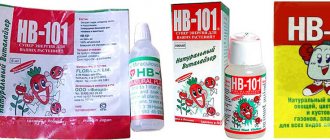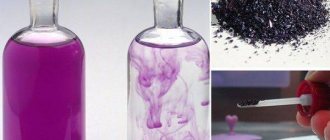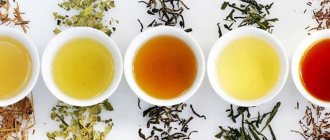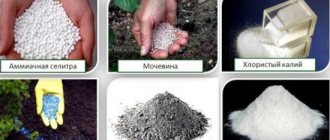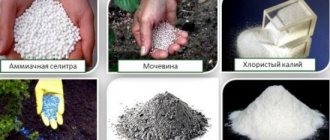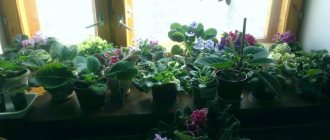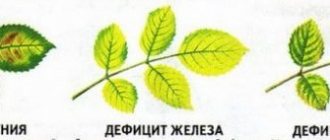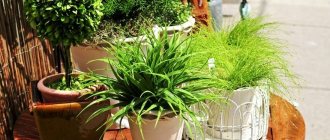What is potassium permanganate
Potassium permanganate has the chemical formula KMnO4 and in everyday life is called briefly and simply - potassium permanganate. Another name sounds like potassium permanganate. From a pharmacological point of view, this substance is considered deodorizing and antiseptic.
When handling potassium permanganate, it is very important to be careful, since it is active with some substances (aluminum, magnesium, phosphorus, calcium, sulfur, glycerin), which can lead to an explosion.
When using dark purple crystals to treat plants and soil, it is advisable to wear gloves. If the concentrated solution gets on the skin, there is a risk of getting burned.
Potassium permanganate for indoor flowers - application and benefits
Prevention of infections in underground organs
Potassium permanganate saves from rot that appears on damaged roots, tubers and bulbs. It is advisable to use it when transplanting corms. If underground organs have been damaged, then after removing the rotten area, you can put them in a container with diluted KMnO4 for 10-15 minutes. But even whole tubers and bulbs cannot be prevented by keeping them in a pink solution of potassium permanganate.
Potassium permanganate against pests of indoor plants
Very often, potassium permanganate is recommended for indoor flowers against midges and other insect pests. Of course, you can try its application in practice for this purpose. But still, I would recommend that in such a situation you use stronger targeted insecticides. For example, “Grom-2”, “Aktara” or the equally effective “Aktellik” can help.
Potassium permanganate is not poisonous to flying insects, so it is difficult to obtain a positive effect. If there are midges on the flowers, you should also reconsider the soil moisture regime.
This substance helps get rid of earthworms if they happen to end up in a flower pot. These soil inhabitants are very useful and necessary in natural conditions, but in the limited space of a container they only cause harm to plants.
Soil disinfection for indoor plants
Powdery mildew, late blight, dangerous gray mold - this is not a complete list of infectious diseases against which potassium permanganate is effective. It is used as a prophylactic against fungus and as an active component in the fight against it.
When replanting plants, do not forget to disinfect not only the soil, but also the pots and tools for work.
Accelerating berry set
If you grow fruit-bearing fruit crops at home (for example, strawberries, citrus fruits), then you can use a solution of microelements to stimulate fruiting. In this case, the use of potassium permanganate in combination with boric acid and ash gives good results.
The proportions of the starting substances for the preparation of such a product are as follows: potassium permanganate and boric acid - 1 g each, sifted ash - ½ cup, water - 5 liters.
Stimulation of seed and cutting growth
The use of potassium permanganate as a stimulator of seed germination during the independent propagation of many indoor plants is justified. To do this, the seed buds are soaked in a KMnO4 solution for 30-40 minutes. At the same time, seeds are disinfected before sowing.
Soaking in a permanganate solution is also used in green cuttings. In this case, it is a mineral stimulator of root growth. Potassium permanganate can replace heteroauxin if you don't have it on hand.
The method of soaking seeds and cuttings can be used not only for indoor flowers, but also for garden plants. This is effective for cucumbers, peppers, cabbage, eggplants and tomatoes before sowing them as seedlings. It is also useful to soak the seeds of dill, parsley and other greens if you grow them on the windowsill.
Potassium permanganate for indoor plants as fertilizer
Since this substance is a source of manganese and potassium, if there is a shortage of them, it is advisable to consider potassium permanganate as a plant food. To determine whether there is a deficiency of these elements, you need to pay attention to the following features.
Signs of potassium deficiency are:
- dull greenish-blue leaf color;
- yellowing of the leaf blade along the veins;
- brown or brown tips of leaves;
- lack of flower buds;
- curling of leaves along the edge.
Signs of manganese deficiency are:
- chlorosis between the veins or at the base of young leaves;
- brown spot and leaf dieback.
Disinfectant solution for flower bouquets
Of course, plants grown in a garden or meadow are not considered indoor plants. But, since we often put them in a vase at home, I thought it would be appropriate to talk about them. It is useful to add potassium permanganate to the water in which cut flowers stand. It disinfects the solution and thereby extends the shelf life of the bouquet.
Potassium permanganate to stimulate root formation of cuttings and seeds.
When propagating indoor plants by seeds or cuttings , you can also use potassium permanganate. The seeds are soaked for 30-40 minutes in a weak solution of potassium permanganate and then planted in the ground. In this case, you kill two birds with one stone - you disinfect the seeds and stimulate their germination . Cuttings can also be soaked in a solution of potassium permanganate for faster root formation . You can replace potassium permanganate with Kornevin .
Is it possible to water indoor flowers with potassium permanganate?
In different concentrations, a solution of potassium permanganate brings considerable benefits to plants. But what flowers can be watered with potassium permanganate? How often can I spray and water? Let's figure it out.
The frequency of watering indoor plants with manganese is determined by two factors. First, as already mentioned, potassium permanganate is a source of potassium and manganese. They are important and provide certain benefits to plants. But in large quantities they can have a negative effect on the development of the plant organism.
Secondly, when regularly watering indoor flowers with a KMnO4 solution, acidification of the soil occurs. Not all houseplants need and can withstand low pH values. That is why you should follow the watering and spraying regime.
How often can you water flowers with manganese?
If this procedure is needed for preventive purposes, then once every six months is enough. If the use of potassium permanganate for plants is due to some problem, then it is recommended to water indoor flowers more often - up to once a week.
More frequent watering can lead to undesirable consequences. Therefore, it is necessary to use other means in parallel to solve the problem. At home, ash, laundry soap, iodine, and tobacco can help out. In case of urgent need, it won’t hurt to buy professional products.
What flowers can be watered with potassium permanganate?
Despite the fact that the use of potassium permanganate is beneficial for plants, not everyone can withstand its effects. The list of suitable decorative foliage and beautifully flowering plants includes those who love acidic soils. First of all, these are tropical crops:
- Begonias
- Hydrangeas
- Ferns
- Tradescantia
- Cyperus
- Monstera
- Ivy
- Diefenbachia
- Gardenia
- Chlorophytum
- Zygocactus
- Paunsetia
Other indoor plants that respond well to potassium permanganate:
When growing indoor varieties and seedlings of garden crops at home, you can also use a pink solution to:
Sometimes flower growers wonder whether it is possible to water an orchid with potassium permanganate. Professionals say that you can not only water the soil with it, but you can also treat the root system. Read more about growing orchids after purchase here. Let me just say briefly that potassium permanganate is suitable for orchids and violets as a disinfectant and nourishing agent.
Especially for orchid lovers, there are two books in electronic format, which contain all the necessary information on growing these plants. The first book is called "Home First Aid Kit for Orchids." It was written by a professional in his field, but in a very simple and understandable language. In addition, the book contains many illustrations.
The second book, “Secrets of Orchid Care,” contains extensive material based on personal experience, provides numerous recommendations, and reveals secrets that few people know about. The authors of both books guarantee their readers support and answers to all questions about caring for these delicate flowers.
Who is this watering suitable for?
Now let's take potassium permanganate as a whole substance, without breaking it down into its constituent elements. How will such a solution behave in the soil?
It slightly acidifies the soil. So, it is well suited for those plants that prefer acidic soil. It is in it that the absorption of manganese is maximum. In alkaline soil, poorly soluble compounds of this element are formed, which are poorly absorbed by plants.
Plants that prefer acidic soil most often came to us from the tropics:
- begonia,
- gardenia,
- hydrangea,
- dieffenbachia,
- fern,
- poinsettia,
- tradescantia,
- Cyperus.
As you understand, the list is far from complete; I have given only a few names as examples. Complete information on such plants can be easily found on the Internet. I honestly can’t say anything about garden plants and trees, I’m not interested in it. If anyone is interested, then maybe this will help you.
In addition, citrus fruits, violets, pomegranates, and peppers feel good when watered with a permanganate solution. I wish I had known about this when I was growing my cute purple peppers.
How to dilute potassium permanganate for plants
The use of potassium permanganate in everyday life and for caring for indoor flowers is quite wide. But in different cases it is necessary to prepare solutions of different concentrations. KMnO4 must be diluted until the crystals are completely dissolved. Otherwise, the leaves or roots of the plant may be burned.
It is important to remember about the shelf life of the finished solution - it is limited to 3-4 days.
To spray indoor flowers, you must use a pale pink solution. The proportions are as follows - 1 g of crystalline powder per 5 liters of water. If you take a small amount of it in your palm, it should be almost transparent.
To disinfect soil with potassium permanganate, you need to dilute 1-3 g of crystals in 5 liters of settled water. By the way, this solution is also used to cultivate the soil in a greenhouse.
To soak the seeds, use a 0.5% solution. To prepare it, 0.5 g of crystalline powder is dissolved in 100 ml of water.
To feed plants, use a solution made from 1.5 g of crystals per 5 liters of water. This liquid can also be used to treat the soil under garden plants that need additional potassium and manganese.
This is how potassium permanganate is used for indoor flowers. Agree that this common and cheap substance is a very important assistant in raising green pets.
I wish you successful and enjoyable work with plants!
An affordable and effective product, potassium permanganate, is especially popular among floriculture lovers. This budget drug is both a medicine, a nutritional supplement, and an antiseptic, which only confirms its versatility. The main thing is to know how to use potassium permanganate for indoor flowers, so as not to harm them instead of benefiting them. When using a highly concentrated solution, there is a high probability of burns on both the leaves and the root system of the home crop.
Yulka
That is Fungus gnats
Once you improve your care, eliminate errors when watering, potassium permanganate is not needed.
Weak pink solution. You can also try a weak solution of planed laundry soap.
The seeds are soaked for 20 minutes in a 0.5% solution of potassium permanganate (0.5 g per 100 ml of water). Before planting the seeds of any vegetables or flowers, water the soil in the box with a special solution: 3-5 g of potassium permanganate per 10 liters of water. This will protect the seedlings of tomatoes, eggplant, peppers, cabbage from the “black leg”.
I wish you good luck!!!with caution. For example, you should not use eggshells for plants that prefer acidic soil, and coffee grounds for those that grow in alkaline soil.
10. Egg shells. Suitable for all plants, except those that prefer acidic soil (azalea, camellia, indoor hydrangea). To feed plants, an infusion is prepared once a month: eggshells crushed in a coffee grinder are poured with water and infused for 12-15 days in a dark place.
What benefits are contained in potassium permanganate?
Dark purple crystals are of particular value for plants because they contain two important chemical elements - manganese and potassium. The formula of potassium permanganate is KMnO4. A solution of potassium permanganate works well as a disinfectant; it is good to soak seed in it to destroy pathogenic microorganisms and saturate the seeds with a starting supply of manganese. When using potassium permanganate, the grown products are environmentally friendly and rich in useful components.
In addition, manganese acts as an accelerator of the respiration process in plants, which is involved in photosynthesis. If we take into account the high redox potential of this chemical element, its benefits for plant cells can be compared with the value of iron for animals. Pink working liquid is often used to disinfect the soil substrate; for example, it helps to get rid of Saintpaulia that accidentally got into a flower vessel.
Plants absorb this microelement best when the soil is acidic (from 6.0 pH); if the acidity level is above 7.5, then difficult-to-digest Mn(OH)2 hydrate is formed.
Confirmation of the benefit of a budget drug for indoor plantings is the observation of I.V. Michurin, who noted that hybrid almond seedlings begin to bear fruit with a sufficient quantity already in the 6th year.
Potassium, like manganese, belongs to the group of vital elements for green spaces. It increases their immunity and level of resistance to adverse environmental factors. A particularly acute shortage of it is experienced by young plants that are in the stage of active growth and development. Thanks to it, sugars and amino acids are transported in tissues, water metabolism and the process of photosynthesis are regulated.
Is it possible to water indoor flowers with potassium permanganate?
The use of potassium permanganate has a beneficial effect on home crops. Among the advantages of a weak solution of potassium permanganate, experienced gardeners note:
- The ability to resist putrefactive processes. Dark purple crystals help save plants from rot that develops on damaged tubers, roots and bulbs. It is more effective to use them when transplanting corm crops. Treatment with potassium permanganate involves soaking for 10-15 minutes. damaged underground plant organs. Preventive measures using this drug will also be relevant.
- Action against pests . The working fluid works perfectly against midges on flowers and other parasitic individuals that oppress them with their vital activity.
- Antifungal effect . Potassium permanganate is often used as a prophylactic against powdery mildew, dangerous gray rot and late blight. To avoid the occurrence of such ailments, it is recommended to treat not only the soil substrate, but also the tools used, with a solution of potassium permanganate.
- Acceleration of fruit set. When growing fruit crops at home, for example citrus fruits, a weak solution of potassium permanganate, thanks to its beneficial components, stimulates the fruiting process. Especially if you use it together with wood ash and boric acid. The ingredients are taken per 5 liters of water: 1 g of boric acid, ½ cup of ash and 1 g of potassium permanganate.
- Activation of growth of planting material (seeds, cuttings) . This use of potassium permanganate gives a positive result when breeding indoor crops. The seeds are kept for 30-40 minutes in pink liquid, which also allows them to be disinfected before planting in the ground. This technique is also useful for green cuttings, where the working fluid acts as a mineral growth stimulator of the underground mass. This is a worthy alternative to Heteroauxin. It is also effective to treat seeds of dill, parsley and other herbs with potassium permanganate when grown at home.
- The content of potassium and manganese allows the drug to be used as a nutritional mixture. But in order not to overdo it and not provoke undesirable consequences, it is necessary to add potassium permanganate to the soil only if there are obvious reasons for this, when there are no flower buds, leaves curl, leaf blades along the veins turn yellow, and the color changes to greenish-blue. These are all signs of potassium deficiency. If yellowing is observed between the veins or near the base of new leaves, there are brown spots, then there is a need to add manganese.
- The disinfecting properties of potassium permanganate make it possible to extend the shelf life of a collected or gifted bouquet. Dark purple crystals are added to the water that is in the vase.
Watering flowers with a solution of potassium permanganate is certainly useful and necessary, but you need to do this in moderation, and know which crops tolerate it. Among such plantings are alocasia, abutilon, amaraliss, aspidistra, asparagus, azalea, begonia, and anthurium. It is also good to cultivate the soil under gardenia, hydrangea, diefenbachia, kalanchoe, calathea, and calami. Monstera, primrose, pelargonium, poinsettia, violet, and ivy react quite normally to potassium permanganate. You can water ficus, spathiphyllum, cyclamen, fuchsia, cyperus, and shefflera. The use of potassium permanganate against midges in flowers both saves the plantings and feeds them.
How to dilute potassium permanganate for flowers
As a prophylactic agent, the pink solution is used once every six months. If house flowers are sick or pests appear, then potassium permanganate is used once every 7 days.
To prevent side effects from occurring, it is recommended to use other means in addition to potassium permanganate: wood ash, laundry soap, tobacco, iodine. If the scale of the damage is quite serious, then it is better to purchase insecticidal preparations.
Depending on the purpose of the working solution, potassium permanganate is diluted in water until the crystals are completely dissolved in the required concentration:
- To spray indoor plants, use 1 g of the drug per 5 liters of water. The working solution should be pale, almost transparent.
- To disinfect the soil substrate, 1-3 g of potassium permanganate are diluted in 5 liters of water.
- To treat planting material, use potassium permanganate in an amount of 0.5 g per 100 ml of water.
- For feeding procedures, 1.5 g of product diluted in 5 liters of water is sufficient.
The shelf life of pink liquid is only 3-4 days. Dilute the drug in warm water, the temperature of which does not exceed 30-40 degrees. It is first recommended to dissolve the crystals in a small volume of liquid, and then bring it to the desired volume by adding water.
The recipe for fertilizer with potassium permanganate is as follows:
- boric acid 1/3 teaspoon
- potassium permanganate on the tip of a toothpick
- 3-5 drops of iodine
- 3 liters of water
Boric acid must be dissolved separately in warm water (40-45 degrees), until the crystals are completely dissolved. Also dissolve potassium permanganate in a prepared container in 3 liters of water until a pale pink color is obtained. Then add 3-5 drops of iodine. Lastly, add dissolved boric acid. With this solution it is necessary to carry out both root and extra-root feeding of domestic plants.
Important! Fertilizing should only be done on watered plants; it is not recommended to apply fertilizing to dry soil.
A solution of potassium permanganate allows you to compensate for the lack of microelements such as potassium and magnesium. In addition, it has a beneficial effect on fruiting indoor plants, such as pomegranate, persimmon, citrus fruits (lemon or orange). But an excess of microelements can lead to undesirable consequences. Therefore, do not abuse this substance.
How to water correctly
When using manganese, the main thing is to wait until its crystals are completely dissolved, and only then use it against midges, as a feed or against rot. Water the flowers with diluted potassium permanganate at the root, allowing the soil to dry out after the previous time. If midges have infested indoor crops, it is also recommended to adjust the frequency of moisturizing procedures.
Treating flowers with potassium permanganate against pests is a completely effective and affordable way to combat them. It is important to apply the pink solution in a timely manner and not allow excess moisture in the soil. To avoid burns, the concentration of dark purple crystals should not be exceeded.
Potassium permanganate, or as it is often called, potassium permanganate, is a well-known antiseptic and disinfectant, widely used for household and medical purposes. But in addition to this, a solution of potassium permanganate has also found its use in gardening. Let's consider the need for manganese for plants, its use as a means of protection against diseases and pests, as well as fertilizer.
Potassium permanganate for parasites and pests
It is believed that a solution of potassium permanganate not only disinfects and disinfects, but also helps in the fight against insect pests. There is a deal of truth in it.
My experience shows that potassium permanganate can be used in combination with other pest control agents, but do not rely on it alone, since potassium permanganate is not a poison for most insect pests.
Potassium permanganate alone will not help you cope with insect pests.
Will potassium permanganate help against midges? No - you cannot remove flying insects from your plant using potassium permanganate alone. Use special insecticides for this. To combat insect pests, I advise you to use ready-made preparations Fufanon and Actellik.
Potassium permanganate against pests
The use of manganese to protect plants from pests also gives good results:
- wireworm damaging root crops;
- flies of different types;
- slobbering pennies threatening strawberries.
In the first two cases, you can get rid of pests if, before planting, you spill the soil with a saturated solution of potassium permanganate (5 g of the substance per 10 liters of water), and also soak the seeds and tubers. To destroy the strawberry pest, it is enough to pour hot (about 65º) hot (about 65º) potassium permanganate with a bright pink consistency. Such hot washes carried out in the evening are useful for bushes at any stage of their development. Only for young bushes the temperature should not be higher than 45º.
You can disinfect gardening equipment using such an inexpensive product
Control of plant diseases
Potassium permanganate is also effectively used both for the prevention and treatment of fungal viruses in cultivated plants.
Late blight or late blight
Late blight mainly affects nightshade crops. For preventive purposes, it is recommended to generously spray tomato, pepper, eggplant and potato bushes with a special medicinal solution every two weeks: take 2-3 g of potassium permanganate crystals and a glass of squeezed garlic into a bucket of water. The mixture is left to stand for 3-4 hours, filtered and 2 tablespoons of liquid soap are added to it so that the solution sticks to the plants.
Powdery mildew
Unfortunately, powdery mildew is known to many gardeners and gardeners. It affects strawberries, currants, raspberries, other berry bushes and fruit trees, cucumbers and other melons, as well as flowers. At the first symptoms of the disease, it is necessary to dilute a bright pink solution of manganese and generously spray all affected parts of the plants. Treatment should be carried out 3-4 times every 5 days.
Gray rot
A fungal plant disease such as gray rot most often affects strawberries, grapes, raspberries, cabbage, and onions. To protect crops from this fungus, you can also use sprinkling with a solution of potassium permanganate. In spring, you should use a pale pink mixture (2 g per bucket of water), and before setting fruit, it is recommended to use a more saturated consistency (1 g of substance per liter of water).
To prevent plants, it is effective to use a solution of potassium salt
Blackleg
A solution of potassium salt of permanganic acid can also actively fight blackleg, a disease that often affects vegetable seedlings, and sometimes adult tomato bushes, cabbage, and flowers. For prevention, it is recommended to water the seedlings at the root with a slightly pink mixture of potassium permanganate. When a disease appears, the damaged plant must be removed along with a layer of soil, add ash or sand and generously spill the soil with a saturated solution of potassium permanganate.
Use as a top dressing
Permanganic acid is also recommended for use as a feed for crops lacking magnesium and potassium. Feeding plants with manganese stimulates the development of the root system, the production of necessary sugars and acids, and the setting and ripening of fruits. It plays an important role in photosynthesis and respiration of plants, and improves their immunity.
The main thing to remember is that you should not overdo it with fertilizers, since an excess of manganese in plants will damage them no less than its deficiency. In addition, it is necessary to strictly observe the proportions when preparing the solution, since a stronger concentrate will lead to burns and death of crops.
It is recommended to use permanganic acid as a feed for crops.
Main symptoms of manganese deficiency
Manganese deficiency in plants manifests itself in the following signs that you need to pay attention to:
- yellowing of leaves between the veins and at their base;
- the appearance of yellow spots and dots on the leaves, which over time turn into light yellow necrotic spots;
- leaf dying.
Sugar beet roots
For the development of sugar beet roots, foliar fertilizing with a solution of potassium permanganate has a good effect. They can be carried out several times a season by watering the tops or spraying. The mixture is prepared at the rate of 5 g of substance crystals per bucket of water (10 l).
Potato
In mid-summer, it is effective to feed potatoes with a solution of potassium salt of permanganic acid. To do this, dissolve 3 g of crystalline powder in 10 liters of water.
Iodine
Iodine plays an important role in the processes in the body of humans and animals; the lack of this element greatly affects health. As for plants, iodine does not require special addition in fertilizing. Plants are able to capture iodine from the atmosphere; it is often found as impurities in fertilizers, and peat, which is the basis of most soils for indoor plants, contains it in significant quantities.
Plants clearly do not respond to iodine deficiency. However, the literature provides examples of its beneficial effect on some agricultural crops, but there is no exact explanation for this phenomenon yet. Plants are able to accumulate iodine in their tissues, which is very valuable when growing forage crops and vegetables, but for growing indoor plants that are not consumed as food, this ability is not important.
The stimulating effect of iodine on plants is noted at its content of 0.1 mg/kg in the nutrient solution. But already at a concentration of 0.5-1.0 mg/kg a toxic effect is observed. Thus, adding a large amount of brown algae ash to the soil causes iodine poisoning, which manifests itself in marginal chlorosis of adult leaves and dark green coloring of young leaves.
When using any substances while growing potted plants, it is extremely important to remember that the volume of soil is small, any careless application or exceeding the dose can have a detrimental effect on the plants.
When adding one drop of pharmaceutical iodine per liter of water, the iodine concentration will be approximately 1-2 mg/kg, which is 10 times higher than the stimulating concentration and turns it into a poisonous one. For a stimulating effect, it is enough to add a drop to a bucket of water, but such a volume is too large for house plants.
For open ground plants, a dosage of 1 drop per 3 liters of water is often recommended for watering and spraying against fungal diseases, which is closer to the norm; moreover, the volume of soil in the garden is much larger. Do not exceed at least this concentration, first test it on a small part of the plants, consider these treatments against diseases as preventative, and at the first signs of fungal diseases, use agrotechnical measures and fungicides to preserve the harvest.
We invite you to find out what plants grow in the meadow
